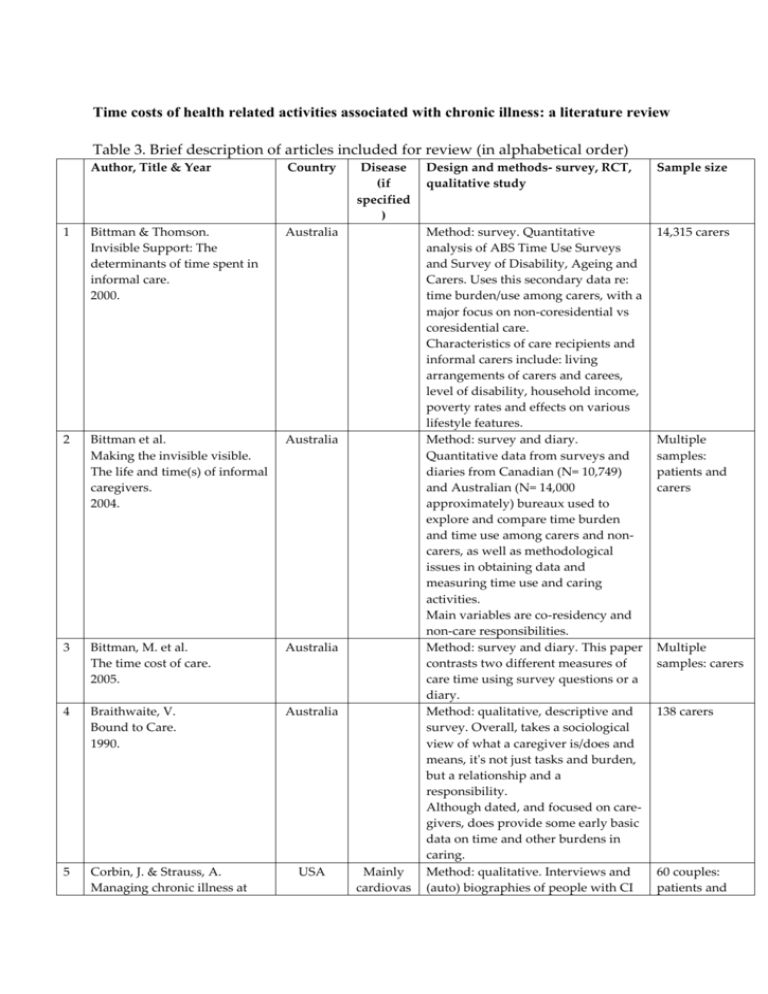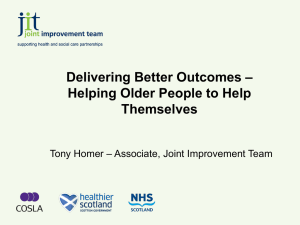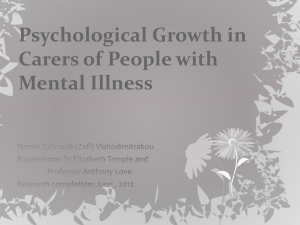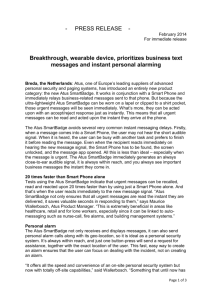Time costs of health related activities associated with chronic illness
advertisement

Time costs of health related activities associated with chronic illness: a literature review Table 3. Brief description of articles included for review (in alphabetical order) Author, Title & Year Country 1 Bittman & Thomson. Invisible Support: The determinants of time spent in informal care. 2000. Australia 2 Bittman et al. Making the invisible visible. The life and time(s) of informal caregivers. 2004. Australia 3 Bittman, M. et al. The time cost of care. 2005. Australia 4 Braithwaite, V. Bound to Care. 1990. Australia 5 Corbin, J. & Strauss, A. Managing chronic illness at USA Disease (if specified ) Mainly cardiovas Design and methods- survey, RCT, qualitative study Sample size Method: survey. Quantitative analysis of ABS Time Use Surveys and Survey of Disability, Ageing and Carers. Uses this secondary data re: time burden/use among carers, with a major focus on non-coresidential vs coresidential care. Characteristics of care recipients and informal carers include: living arrangements of carers and carees, level of disability, household income, poverty rates and effects on various lifestyle features. Method: survey and diary. Quantitative data from surveys and diaries from Canadian (N= 10,749) and Australian (N= 14,000 approximately) bureaux used to explore and compare time burden and time use among carers and noncarers, as well as methodological issues in obtaining data and measuring time use and caring activities. Main variables are co-residency and non-care responsibilities. Method: survey and diary. This paper contrasts two different measures of care time using survey questions or a diary. Method: qualitative, descriptive and survey. Overall, takes a sociological view of what a caregiver is/does and means, it's not just tasks and burden, but a relationship and a responsibility. Although dated, and focused on caregivers, does provide some early basic data on time and other burdens in caring. Method: qualitative. Interviews and (auto) biographies of people with CI 14,315 carers Multiple samples: patients and carers Multiple samples: carers 138 carers 60 couples: patients and home: Three lines of work. 1985. 6 Ettner, S. et al. Investing time in health: do socio-economically disadvantaged patients spend more or less extra time on diabetes self-care? 2009. USA 7 Hu, P. & Reuben, D. Effects of managed care on the length of time that elderly patients spend with physicians during ambulatory visits. 2002. Infante, et al. How people with chronic illnesses view their care in general practice: a qualitative study. 2004. Ironmonger, D. The value of care and nurture provided by household work. 1994. USA 8 9 cular diseases, cancer, stroke, & spinal injuries. Diabetes Australia Australia 10 Jenkins, C. Women, work, and care giving: How do these roles affect women's well-being? 1997. USA 11 Langa, K., et al. Informal caregiving for chronic lung disease among older Americans. 2002. USA Lung disease and their spouses. Uses the concept of "work" in managing CIs and types of work: illness, everyday and biographical work. carers Method: survey. Comprehensive survey and statistical analysis, using several variables (education, marital status, income, minority group/ethnicity status, work status, clinical characteristics) but limited to one CI; looks at only foot care, exercise and (conflates) shopping/cooking. Objective: To examine associations between socioeconomic position and extra time patients spend on foot care, shopping/cooking, and exercise due to diabetes. Method: survey. Cross-sectional analysis of the 1998 National Ambulatory Medical Care Survey. 11,927 patients Method: qualitative. 12 focus groups. Objectives: To explore the perceptions of patients with chronic conditions about the nature and quality of their care in general practice. Method: survey. Comparative statistical analysis of mainly ABS survey data of aggregates hours for aged care and related household activities Method: survey. Statistical analysis of data from the 1988 National Survey of Families & Households (USA); how much time in care-giving and other activities, and effects on stress levels. Method: survey. Multivariable regression models using data from the 1993 Asset and Health Dynamics Study by survey. Measurements: Weekly hours of informal care giving, and imputed cost of caregiver time. The average number of hours per 76 patients 4,964 elderly patients Multiple samples: carers 14,500 female carers National populationbased sample of 7,443 communitydwelling elderly patients >70. 12 13 14 15 McCoy, L. Time, self and the medication day: a closer look at the everyday work of 'adherence'. 2009. McKenna, K. et al. Comparison of time use, role participation and life satisfaction of older people after stroke with a sample without stroke. 2009. Paoletti, I A half life: Women caregivers of older disabled relatives. 1999. Pritchard, P. Doctors, patients and time 1992. Canada HIV Australia Stroke 79 patients Method: qualitative & time use diary. Interviews with 23 participants and data compared with a prior study. Interviews prompted participant recall using calendars and diaries. 23 patients >65 yrs old 1-3 yrs post-stroke (mean age 74.2 years, 69.6% men) Italy Method: qualitative. Interviews and discourse analysis. 50 female paid and unpaid carers. UK Method: Descriptive. A narrative description about time and time use, different kinds of time, from both patients' and Doctors' perspective, their perceptions of the other's perceptions of time and its use and value. Method: RCT (other). A prospective economic evaluation alongside a randomized controlled trial of 636 patients with hypertension participating in the study's 3 interventions. Medical costs were estimated using electronic data representing medical services delivered within the health system. Intervention-related costs were derived using information collected during the trial, administrative records, and published unit costs. Method: qualitative. A convenience sample of 8 certified diabetes educators to derive consensus-based estimates of the time required for all self-care tasks recommended by the American Diabetes Association. Method: survey. Compilation and statistical analysis of ATUS survey data on Health-Related Activities in America. Method: survey. Compilation and N/A 16 Reed, et al. Economic evaluation of home blood pressure monitoring with or without telephonic behavioral self-management in patients with hypertension. 2010. USA Hyperten sion 17 Russell, L. et al. Time requirements for diabetes self-management: Too much for many? 2005. USA Diabetes 18 Russell, L. et al. Health-related activities in the American Time Use Survey. 2007. Russell, L. et al. USA 19 week of informal care was calculated for: activities of daily living (ADL); and instrumental activities of daily living (IADL). Method: qualitative. 21 interviews and 16 focus-groups with people taking antiretroviral drugs. USA 636 patients. 8 certified diabetes educators (concerning patient time use) 34,000 patients 1,621 random 20 21 22 How much time do patients spend on outpatient visits?: The American Time Use Survey. 2008. Safford, M. et al. How much time do patients with diabetes spend on selfcare? 2005. Wolf, D. Valuing informal elder care. 2004. Yabroff, K. et al. Estimating patient time costs associated with colorectal cancer care. 2005. USA Diabetes USA USA Colorecta l cancer statistical analysis of ATUS survey data on outpatient visits. sample of patients from 2003-06 ATUS data, age >15 Method: survey. Cross-sectional survey of 1482 diabetic patients enrolled in 3 northeastern United States managed care plans. Statistical analysis using and linear regressions. Method: modelling. Addresses through modelling the problem of attaching a monetary value to informal elder care, and why we should; uses NLTCS data to illustrate. Method: survey. Quantitative, longitudinal and comparative time data for cancer/non-cancer care based on past studies and medical records (SEER-Medicare database), and estimates a monetary value of patients' time based on BLS wage rates. 1,482 diabetic patients (57.9% >55 yrs) N/A 75,470 patients with matched controls








